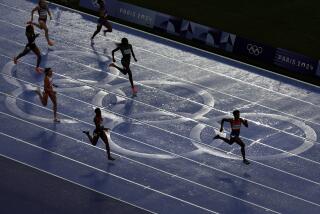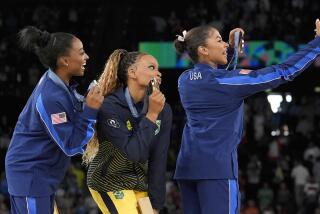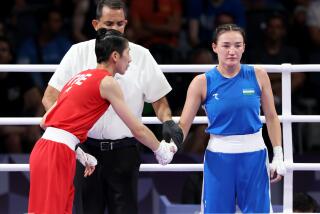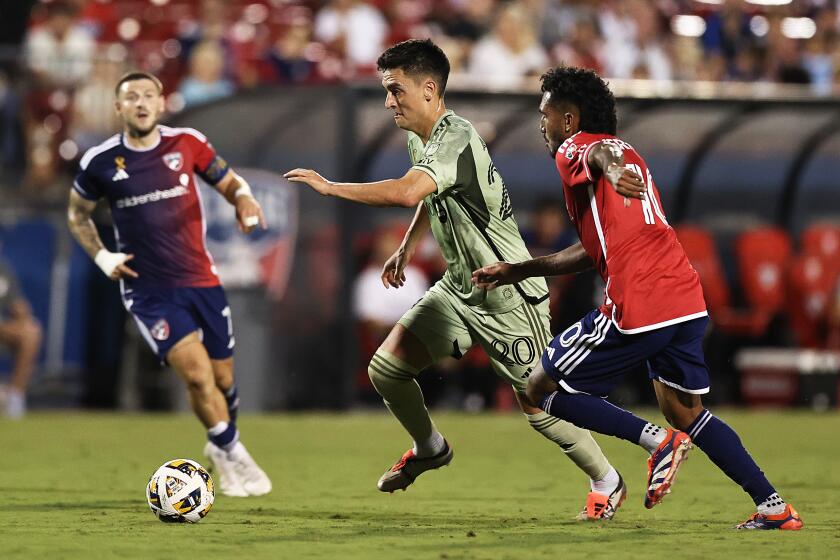Women in sports breaking ground in a way that goes beyond 2015
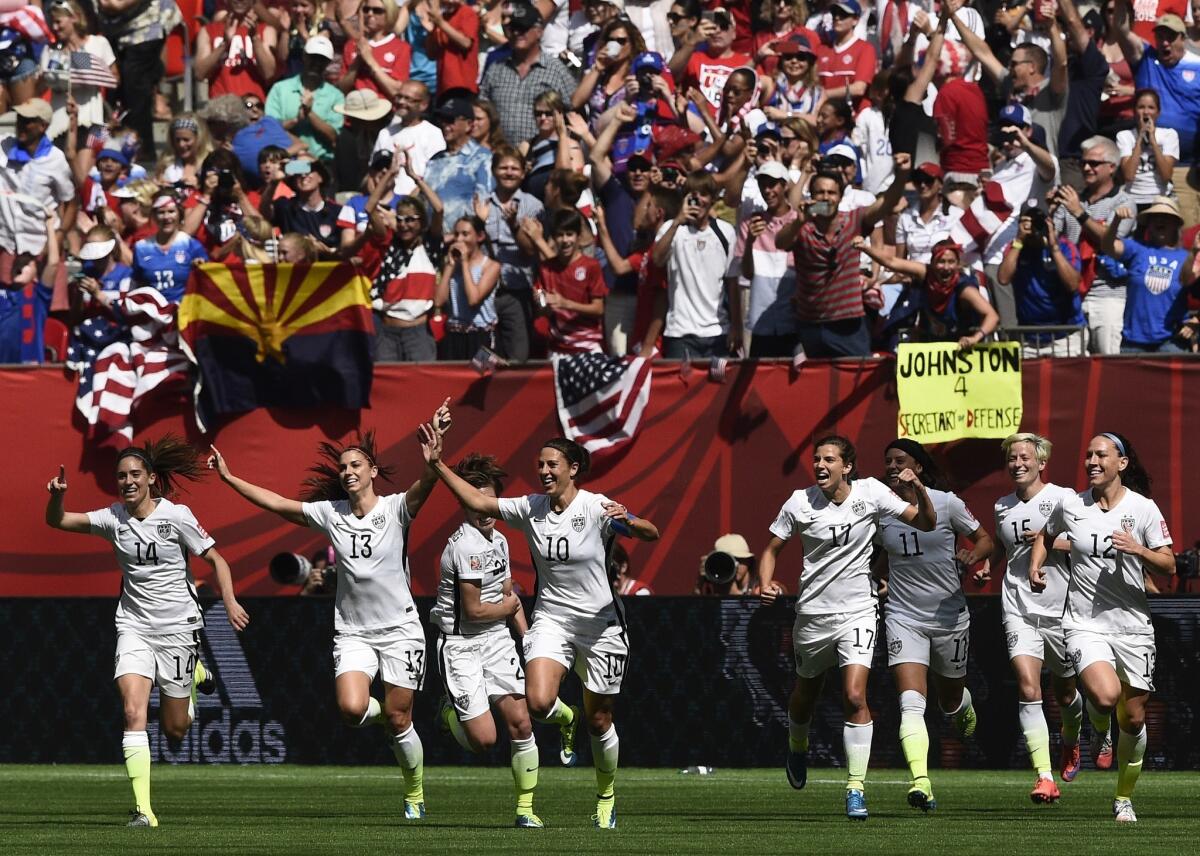
Midfielder Carli Lloyd (10) and he United States teammates celebrate one of her three goals in the Women’s World Cup Final against Japan.
Leave it to the father of two teenage girls to confront the presumption that women are the weaker sex when it comes to sports.
When President Obama welcomed the World Cup champion U.S. women’s soccer team to the White House this fall by saying “playing like a girl means you’re a badass,” his became the loudest voice in a growing chorus acknowledging what has been a breakthrough year for women in U.S. sports.
Over the past 12 months, women have beaten down doors once thought impenetrable. They’ve joined the NFL, both as an assistant coach and as an on-field official, while the NBA now has two female assistant coaches, two female referees and in Michele Roberts, the first woman to head the players’ union in a major men’s professional sports league.
The Oakland Athletics recently became the first major league team to hire a female coach and, in August, ESPN made Jessica Mendoza the first female analyst to work a big league game on a major network.
In mixed martial arts, perhaps the most masculine spectator sport, Ronda Rousey has become the most popular and bankable star despite her recent loss in the octagon. And in July the Women’s World Cup final between the U.S. and Japan was watched by nearly 27 million Americans, the largest U.S. audience ever for a televised soccer match.
And that does not include Mo’ne Davis, whose pitching exploits in the 2014 Little League World Series turned the phrase “throw like a girl” from an insult into a compliment.
“It’s now a part of the landscape. Every single year women are doing incredible things,” says Laura Gentile, founder of espnW, a multimedia platform dedicated to women’s sports. “It’s not another watershed year and then we all go back to normal.”
Susan E. Cayleff, a women’s studies professor at San Diego State, agrees.
“It’s been a landmark year. Part of that has to do with the appeal of certain personalities,” she says. “People have found there’s a fan base for it. People are finally realizing that women’s sports is a serious level of competition and a very fun thing to watch.”
That growth, in both the success of and participation of female athletes, has been building for years. The number of women competing in college sports, for example, has increased more than 300% since 1981. And more than half the teams at NCAA schools are now women’s teams, says Mark Lewis, an executive vice president for the NCAA.
At the end of the day it doesn’t matter. Men, women, mixed. People like to watch quality competition.
— Mark Lewis, an executive vice president for the NCAA
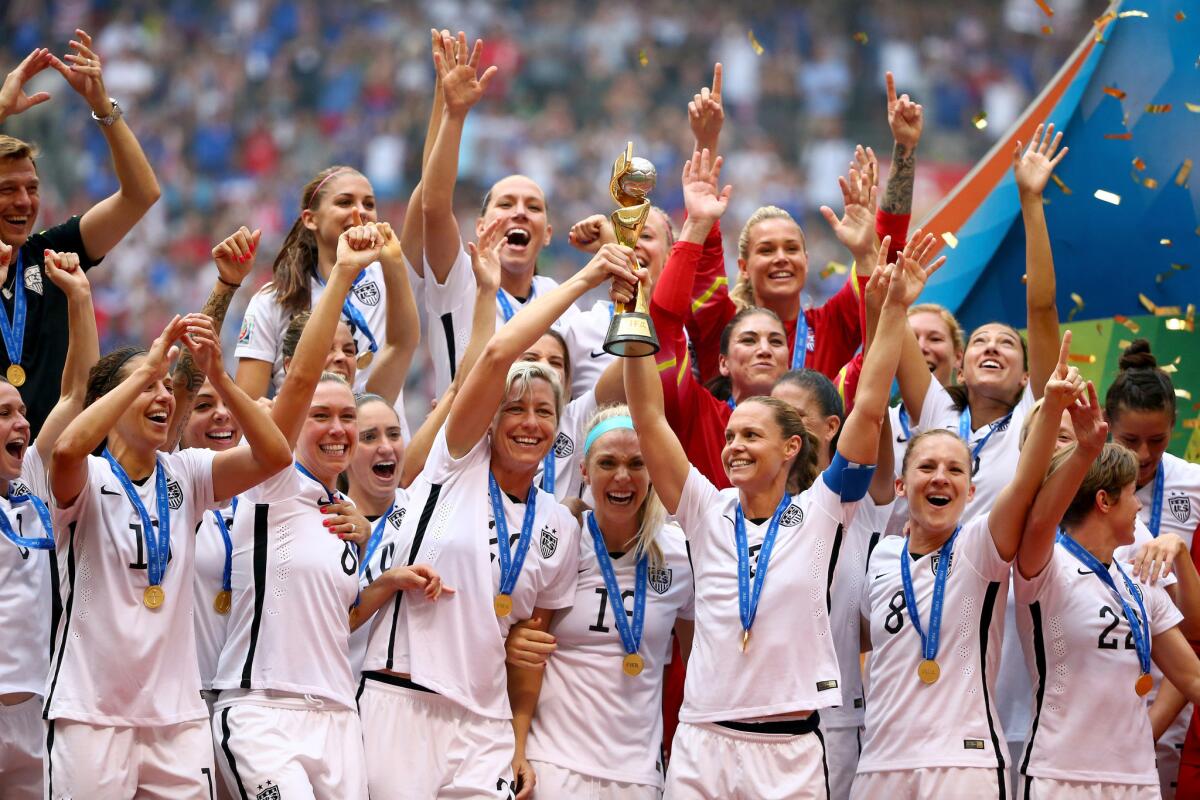
The United States women’s team hoists the World Cup Trophy in celebration.
Title IX, the landmark 1972 federal law prohibiting discrimination on the basis of sex in any federally funded education program, led to equal opportunities for women in college athletics. Female athletes and coaches took that opportunity and ran with it.
“At the end of the day it doesn’t matter. Men, women, mixed. People like to watch quality competition,” says Lewis, who credits the change to expanded opportunities for girls at the high school and youth levels. “Because of the growth of these programs, there’s more athletes to recruit. There’s deeper benches and as a result the competition’s gotten a lot better.”
That’s not to suggest the playing field is level. Parity remains a long way off in several areas, including pay.
In the working world, women earn, on average, 22% less than men for comparable work in the U.S., according to Bureau of Labor Statistics in 2013.
In sports, the gap is much wider.
For winning the Women’s World Cup last summer, FIFA gave the U.S. team $2 million from a total purse of $15 million. A year earlier Germany got $35 million from a $358-million purse for winning the men’s World Cup.
In golf, nine women, led by New Zealand’s Lydia Ko, earned more than $1 million on the LPGA Tour this year. On the men’s side 106 golfers made that much on the PGA Tour. And in the WNBA the average salary was about $72,000 in 2014; in the NBA, the average was $4.5 million.
There are several reasons for that disparity — men’s golf draws nearly 10 times as many TV viewers as the LPGA while the men’s World Cup earned FIFA more than $4 billion.
TV ratings for the NFL, NBA and Major League Baseball continue to swamp women’s leagues, such as the WNBA and the National Women’s Soccer League in viewership. In the NWSL, for example, most games are not available except on YouTube.
As a result, advertising rates for women’s sports on TV often sell for a fraction of the ads shown during men’s games. When Fox bid for the broadcast rights for the next two men’s World Cups, FIFA insisted it take the 2014 women’s tournament for free because soccer’s global body didn’t see the benefit in trying to sell that event. To its credit, Fox took the event seriously and was rewarded with record ratings.
Some, however, place the blame on an old-school approach that continues to dismiss women’s sports as less important.
“Sports is the last sandbox,” says Donna de Varona, a former Olympic swimming champion and a pioneering TV commentator. “It’s very Freudian. ‘It’s challenging our masculinity. Get out of our sandbox.’”
The reason women compare themselves to men ... is because the spotlight is on the men.
— Kate Fagan, former college basketball player and ESPN writer
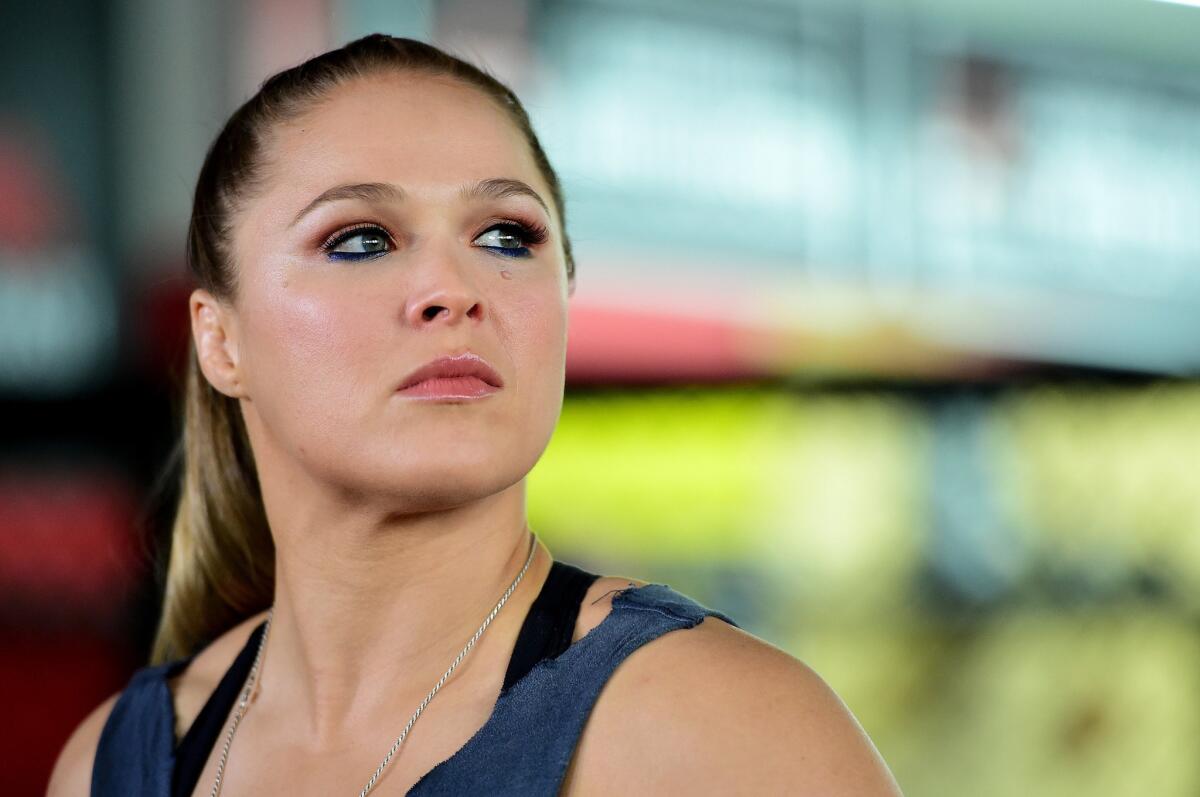
Ronda Rousey speaks during a news conference at the Glendale Fighting Club in October.
For ESPN’s Kate Fagan, a former college basketball player, that mentality forces female athletes to be judged not just on their own abilities but also in comparison to men, who are inherently bigger, stronger and faster.
“Why do we need to validate a Ronda Rousey as an athlete by having her play against the men? Or why do we have the conversation of Brittney Griner, could she play in the NBA?” Fagan asks. “The reason women compare themselves to men … is because the spotlight is on the men.
“No matter how much you stand to the side and wave your arms and you’re like ‘I’m important too’ the spotlight is staying where it is. And you have to go to the spotlight and kind of jump into it to actually get some of the attention that women’s sports need.”
Fagan says the media is responsible for much of that. A recent study by the Institute for Diversity and Ethics in Sport found that 90% of U.S. sports editors are male.
The issue of why the spotlight has so often been focused away from female athletes is not just confined to this country. A 2013 survey by the Women’s Sport and Fitness Foundation found women’s sports in the U.K. received just 7% of the media coverage and less than 1% of the total value of commercial sponsorships compared to men. Nearly identical figures were found in studies in both South Africa and Australia.
“The way we cover women — our tone when we talk on air about women’s sports versus men’s sports — is different,” says Fagan, a former NBA beat writer for the Philadelphia Inquirer. “So all of that stuff contributes to this societal thinking that women’s sports isn’t cool and is boring.
“The thing that makes sports interesting are story lines and stakes. And that’s not inherent to gender. Why are we interested in our kid’s CYO basketball game? Because we have the story line — there’s my daughter out there playing — at the stakes — this is really important to her. So we don’t care whether she can jump 22 inches or three inches. It doesn’t matter.”
But it doesn’t hurt if the athletes are as physical as Rousey or as clutch as U.S. soccer star Carli Lloyd, whose hat trick last summer was the first in a World Cup final in 49 years. Winning also helps, which is why the U.S. women’s soccer team, with three World Cup titles and four Olympic gold medals, and Serena Williams, who has more Grand Slam titles than any active tennis player on the planet, have transcended gender.
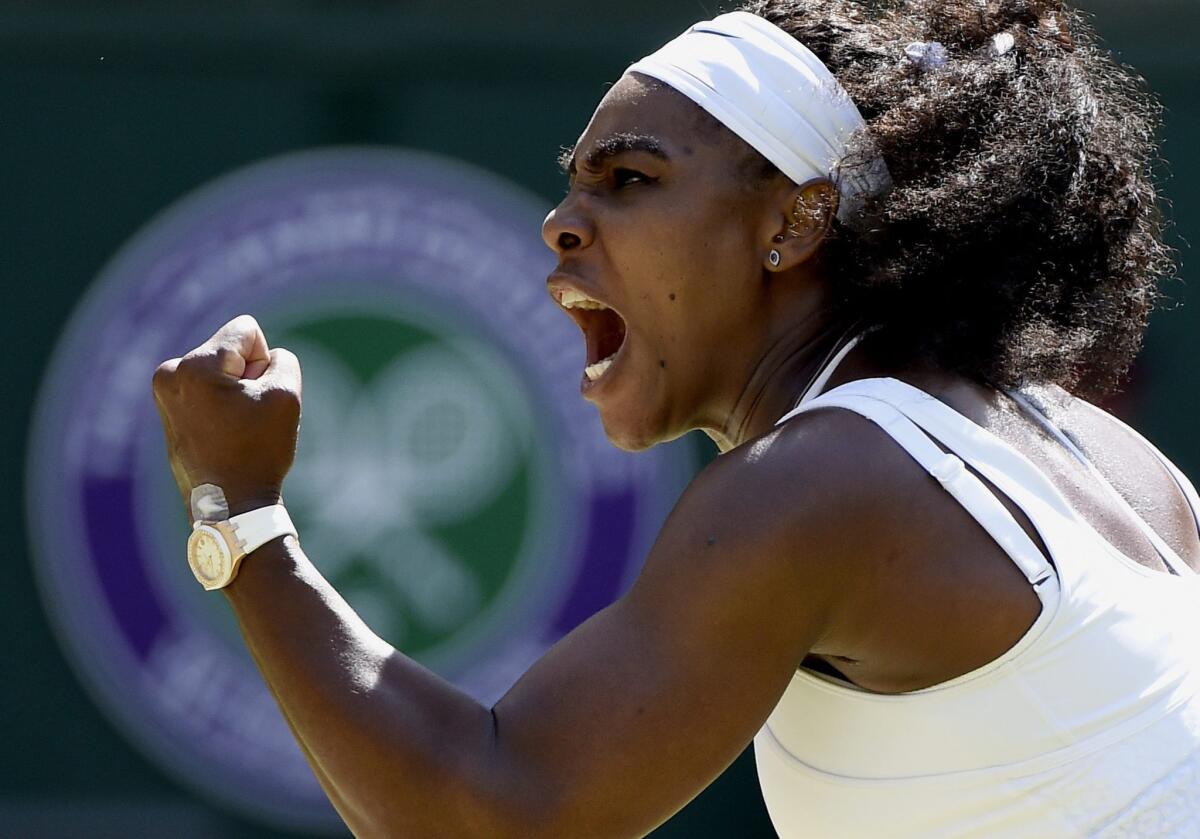
Serena Williams reacts during a match against Garbine Muguruza during the Wimbledon finals in July.
“If women succeed on that level, men and women watch equally. And they’re totally inspiring,” says Gentile, the espnW founder, who hosted a three-day summit on women’s sports in Dana Point last October.
Whether that represents an exemption to the rule or the rewriting of the rule book is uncertain.
“On some level, the elite female athlete is still a bit of an anomaly because in many ways she contradicts stereotypical ideals of femininity,” says Cayleff, the San Diego State professor. “But I would argue we’re at a time where these athletes are setting their own standard.”
The NCAA’s Lewis says companies that once ignored women’s athletics are now becoming corporate sponsors, giving the movement even more momentum.
“They’re finding the decision-makers are often the women in the household and they’re watching women’s sports,” says Lewis, who cites Northwestern Mutual, a Milwaukee-based financial services giant, as an example of an enlightened advertiser. “So they are doing it as a business decision. They want to sell more of their products and they’re finding they can deliver that message at a women’s sporting event.”
But while women’s sports and the athletes who play them have made much progress in terms of respect and attention in recent years, Gentile says it may be another two decades before the transformation is complete.
“I’m confident it’s changing,” says Gentile. “We are growing our audience. You think about women, it’s not this nice little niche. It’s 114 million women, just in the United States alone, who call themselves sports fans. But we need more women in decision-making roles. You still need more women at the top of media empires…. on the league front and as successful commissioners.
“We are going to get there. It’s all trending in the right direction.”
More to Read
Go beyond the scoreboard
Get the latest on L.A.'s teams in the daily Sports Report newsletter.
You may occasionally receive promotional content from the Los Angeles Times.

